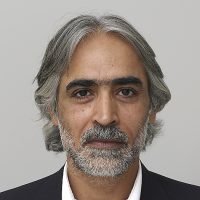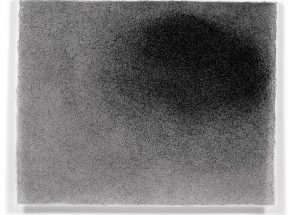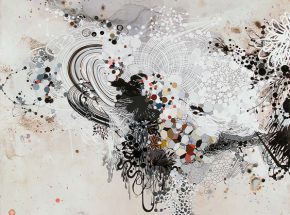

A native of New Delhi, Anil Revri holds a degree in interior design from the Sir J J School of Art, Bombay and a BFA in graphic design from the Corcoran College of Art + Design in Washington, DC. Despite these contrasting backdrops, Revri’s style is an intriguing marriage of these two disciplines and environments. From the Washington Color School’s abstract languages of serialized stripes, dots and circles to the meditative aspects of Middle Eastern arts, Revri’s works offer boundless theories about what truths can be expressed and discovered in the order of visual language. Revri’s geometric abstractions employ a variety of dotted, curved and slanted lines that create an illusion of three-dimensional space. Metallic paints, markers and pencils create patterns within patterns. With subtle elegance, the viewer is simultaneously drawn into the void of negative spaces and repelled as shapes move over and under one another. These serialized patterns are premeditated, each one having internal harmony and a wholly balanced completeness. Implied in the sequence of Revri’s works is that order — both personal and universal — is possible. “Though abstract in their rendering, the work is inspired by Eastern philosophy. Each piece becomes a meditation,” comments Revri. “There is no reference to narrative here, excepting that of an implied order beneath the restless surface.” In his acclaimed series “Cultural Crossings,” Revri explores themes of peace, desire, lust, greed and renunciation through the order of theology. Incorporating calligraphy in different languages from sacred texts and holy writings that address universal human concerns, Revri examines religion through involved, finite and delicate patterns. Eric Denker, Curator of Prints and Drawings at the Corcoran Gallery of Art, adds, “Anil Revri’s elegant and subtle geometric abstractions are visual poems that induce contemplation. At once sensual and serene, they resonate in the inner and outer worlds of the viewers.” Working in series, Revri’s individual works reveal themselves as elements in a larger whole. His concepts come together in a robustly articulated metaphor for the disorder that prevents humanity from achieving the calm it so desires. It is, as Art in America art critic J W Mahoney wrote, “an inner order so complete that its face is, gently, everywhere at once.”
Website
http://www.anilrevri.com

